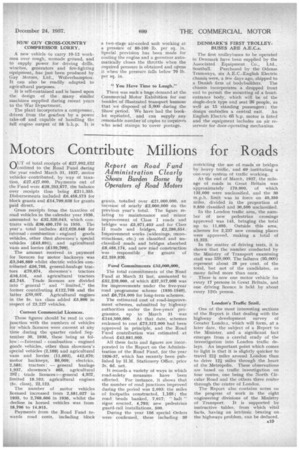Motors Contribute Millions for Roads
Page 7

If you've noticed an error in this article please click here to report it so we can fix it.
nUT of total receipts of £27,992,522 NaCredited to the Road Fund during the year ended March 31, 1937, motor vehicles contributed, by way of taxation, £27,427,000, Payments out of the Fund were £28,203,877, the balance over receipts thus being £211,355. Disbursements included £6,458,573 for block grants and £14,799,038 for grants paid direct.
Gross receipts from the taxation of road vehicles in the calendar year 1936, amounted to £32,320,043, which contrasts with £30,480,176 in 1935. The year's total includes £12,028,648 for internal combustion engined goods vehicles, other than showmen's special vehicles (£43,891), and agricultural vans and lorries (£139,709).
The amount received in payment for licences for motor hackneys was £3,346,889 whilst electric vehicles contributed £56,788, general,haulage tractors £79,674, showmen's tractors £16,516, and agricultural tractors £2,745. Trade licences are divided into " general " and " limited," the former contributing £122,708 and the latter £88,001. Agricultural engines in the Sc. tax class added £5,806 in respect of 23,227 vehicles.
Current Commercial Licences.
These figures should be read in conjunction with the numbers of vehicles for which-licences were current at any time during the quarter ended September 30, 1936, these being as follow :—Internal combustion engined goods vehicles, other than showmen's special vehicles (2,169) and agricultural vans and lorries (11,603), 442,870; motor hackneys, 86,009; electrics, 2,585; tractors: — general haulage 1,937, showmen's 465, agricultural 287; trade licences :—general 4,937, limited 18,103; agricultural engines (5s. class), 22,123.
The number of motor vehicles licensed increased from 2,581,027 in 1935, to 2,768,606 in 1936, whilst the decline in horsed vehicles was from 18,796 to 14,915.
Payments from the Road Fund towards road costs, including block
grants, totalled over £21,000,000, an increase of nearly £2,000,000 on the previous year's total. The figure relating to maintenance and minor improvement of Class I roads and bridges was £5,971,403 and for Class II roads and bridges, £2,286,554.Improvement works (widenings, reconstructions, etc.) on classified and unclassified roads and bridges absorbed £8,488,174, and new road construction -was responsible for grants of £2,359,920,
Fund Commitments £52,000,000.
The total commitments of the Road Fund at March 31 last, amounted to £52,239,000, of which £37,217,000 was for improvements under the five-year road programme scheme (1935-1940), and £6,724,000 for long-term schemes.
The estimated cost of road-improvement schemes, submitted by highway authorities under the five-years' programme, up to March 31 was £144,500,000. At that date, schemes reckoned to cost £73,312,000 had been approved in principle, and the Road Fund contribution was estimated at about £43,881,000.
All these facts and figures are incorporated in the Report on the Administration of the Road Fund, fcir the year 1936-37, which has recently been published by II.M. Stationery Office, price 2s. 6d. net.
It records a variety of ways in which road-safety measures have been effected. For instance, it shows that the number of road junctions improved during the period was 2,093: the miles of footpaths constructed, 1,168; the road bends banked, 7,017; " halt" signs erected, 4,793; new pedestrian guard-rail installations, 500.
During the year 156 special Orders were confirmed, these including 39
restricting the use of roads or bridges by heavy traffic, and 69 instituting a one-way system of traffic working.
At the end of March, 1937, the mileage of roads in Great Britain was approximately 179,000, of which 135,000 were unclassified, and the 30 ra:p.h. limit was in force on 40,350 miles, divided in the proportion of 9,850 classified and 30,500 unclassified.
In the London traffic area, the number of new pedestrian crossings approved was 145, bringing the total up to 11,695. Outside this area, schemes for 2,237 new crossing places were approved, making a total of 15,323.
In the matter of driving tests, it is shown that the number conducted by the Ministry of Transport examining staff was 338,000: The failures (95,000) represent about 28 per cent, of the total, but not of the candidates, as many failed more than once.
There is now one mOtor vehicle foi every 17 persons in Great Britain, and one driving licence is held by about every 12th person.
London's Traffic Snail.
One •of the most interesting sections of the Report is that dealing with the highway development survey of Greater Loncloa, which will form, at a later date, the subject of a Report to the Minister, and a significant fact emerges from a careful study of the investigation into London traffic delays. An important point which comes to light is that it is slightly quicker to travel 22i miles around London than to drive 1211 miles through the heart of the Metropolis. These observations are based on traffic investigation on four routes, one being the North Circular Road and the others three routes through the centre of London.
The Report also contains notes on the progress of work in the eight engineering divisions of the Ministry of Transport. It is supported by instructive tables, from which vital facts, having an intrinsic bearing on. the highways problem, can be deduced.


























